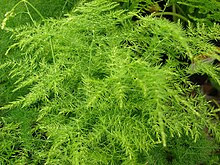Asparagus setaceus
| Common asparagus fern[1] | |
|---|---|

| |
| Scientific classification | |
| Kingdom: | Plantae |
| Clade: | Tracheophytes |
| Clade: | Angiosperms |
| Clade: | Monocots |
| Order: | Asparagales |
| Family: | Asparagaceae |
| Subfamily: | Asparagoideae |
| Genus: | Asparagus |
| Species: | A. setaceus
|
| Binomial name | |
| Asparagus setaceus | |
| Synonyms | |
|
List
| |
Asparagus setaceus, commonly known as common asparagus fern, asparagus grass,[2] lace fern, climbing asparagus, or ferny asparagus, is a climbing plant in the genus Asparagus.[3] Despite its common name, the plant is not a true fern, but has leaves that resemble one.[4]
Naming
[edit]Originally described by the German botanist Carl Sigismund Kunth, its Latin specific epithet setaceus means "hairy".[5]
Description
[edit]
Asparagus setaceus is a scrambling evergreen perennial with tough green stems and leaves, which may reach several metres in length. The leaves are actually leaf-like cladodes up to 7 mm long by 0.1 mm in diameter, which arise in clumps of up to 15 from the stem, making a fine, soft green fern-like foliage. Sharp barbed thorns occur on the stem. Occurring from spring to autumn, the small greenish-white bell-shaped flowers are 0.4 cm long, and are followed by small green berries, which blacken with maturity.[6] They are reportedly toxic upon consumption. If eaten, they can lead to diarrhea and abdominal pain.[7]
Distribution
[edit]It is native to Southern Africa, extending south west as far as Calitzdorp in the Karoo.
It is grown elsewhere as an ornamental plant. It has become an invasive species in several locations where it has been introduced.[8]
Cultivation
[edit]Asparagus setaceus is cultivated as an ornamental plant, for planting in garden and containers, and as a house plant. The attractive foliage is also used in floral arrangements. It is hardy to 1 °C (34 °F), but does not tolerate being frozen. Therefore in temperate zones it is normally cultivated indoors in bright, indirect light.[9]
This plant has gained the Royal Horticultural Society's Award of Garden Merit.[9]
Invasive species
[edit]In Australia it is considered an invasive species and this hardiness has helped it become a weed in Lord Howe and Norfolk Islands.[10] Other areas that regard it as an invasive species and noxious weed include the North Coast of New South Wales,[11] and Queensland.[12]
Toxicity
[edit]Asparagus setaceus is toxic to many domestic animals, including dogs and cats and if they ingest the berries vomiting, diarrhea, abdominal pain and allergic dermatitis may result. The toxic agent within the plant is sapogenin, a naturally occurring steroid.[13][14][15]
References
[edit]- ^ "Asparagus setaceus". Integrated Taxonomic Information System. Retrieved 1 October 2006.
- ^ Asparagus Grass, Adrian Deans, (2023, Hague Publishing) Science fiction novel where a noxious weed becomes a metaphor for a secret alien invasion.
- ^ "Asparagus setaceus (Kunth) Jessop". PLANTS Profile. USDA Natural Resources Conservation Service. 2006-10-01. Archived from the original on 26 September 2006. Retrieved 2006-10-01.
- ^ Zachos, Ellen (2005). Tempting Tropicals: 175 Irresistible Indoor Plants. Timber Press. p. 112. ISBN 0-88192-732-5.
- ^ Simpson DP (1979). Cassell's Latin Dictionary (5 ed.). London: Cassell Ltd. ISBN 0-304-52257-0.
- ^ Climbing Asparagus Archived September 27, 2011, at the Wayback Machine
- ^ Walliser, Jessica (2021-11-30). "Plumosa Fern: How to Grow and Care for This Unique Houseplant". Savvy Gardening. Retrieved 2023-12-05.
- ^ "Asparagus setaceus". Pacific Island Ecosystems at Risk (PIER). Institute of Pacific Islands Forestry. 2005-12-03. Archived from the original on 19 August 2006. Retrieved 2006-10-01.
- ^ a b "RHS Plantfinder - Asparagus setaceus". Royal Horticultural Society. Retrieved 12 January 2018.
- ^ "Asparagus plumosus". Flora of Australia Online. ABRS, ©Commonwealth of Australia. 1994. Archived from the original on 2016-03-04. Retrieved 2009-07-29.
- ^ NSW North Coast Weeds Advisory Committee (2004). "Asparagus (Climbing) (Asparagus plumosus)". Bushland Friendly Nursery Scheme website. Bushland Friendly Nursery Scheme. Archived from the original on 2009-09-13. Retrieved 2009-07-29.
- ^ Sonia Jordan (2007). "Feathered asparagus fern". Queensland Gov't website. State of Queensland (Primary Industries and Fisheries within the Department of Employment, Economic Development and Innovation). Archived from the original on 11 July 2009. Retrieved 2009-07-29.
- ^ "Ten Household Plants Dangerous to Dogs and Cats | Neighorhood Pet Clinic". npcvet.com. Retrieved 2024-06-24.
- ^ "Asparagus Fern Poisoning in Dogs - Symptoms, Causes, Diagnosis, Treatment, Recovery, Management, Cost". wagwalking.com. Retrieved 2024-06-24.
- ^ "Asparagus Fern | ASPCA". www.aspca.org. Retrieved 2024-06-24.
